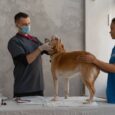As much as we love our pets, there sometimes come circumstances in which they might need to undergo a surgical procedure. The thought may be frightening, but with the right knowledge and guidance, you can ensure your pet gets the best care possible. This guide guide aims to help you understand the necessary precautions that should be taken before your pet’s surgery.
When Is Surgery Necessary for Your Pet?
Just like for us, surgery for our pets is typically considered a last resort when other non-invasive treatment methods have not worked. It’s crucial to have open discussions with your veterinarian about the necessity and implications of surgery. It would be best to opt for a pre-surgery checkup at a reliable place, such as a pet lab in La Mesa, CA.
Understanding Different Types of Pet Surgeries
- Oral/Dental Procedures
- Soft Tissue Surgery
- Orthopedic Surgery
Each surgery type requires its unique preparation. For instance, pets undergoing dental procedures may need specific oral care before the procedure.
The Importance of Pre-Surgery Veterinary Visits
Before surgery, your pet will have to undergo a series of checkups and tests; this may include a comprehensive pet wellness exam. If you need more info on this, don’t hesitate to consult your veterinarian.
Pre-Operation Tests
Before your pet undergoes operation, your vet will order a series of tests to ensure that your pet is in good health and can handle the stress of the procedure. Some of these tests might include:
- Complete Blood Count (CBC): A CBC comprehensively analyzes different cells in your pet’s blood, such as red and white blood cells and platelets. This test observes abnormalities and can reveal potential problems such as anemia, infections, and blood clotting.
- Chemistry Panel: This test provides an overview of your pet’s metabolic status. It checks the functionality of various organs, such as the liver and kidneys. It also measures electrolyte levels that can significantly impact your pet’s health.
- Urinalysis: A urinalysis is a test of your pet’s urine and can aid in the diagnosis of urinary tract infections, diabetes, dehydration, kidney problems, and other health issues.
- X-Rays and Ultrasounds: X-rays and ultrasounds provide an internal view of your pet’s body, and they can identify health problems such as tumors, bone fractures, heart lung disorders, and more.
- Electronic Cardiography (ECG): An ECG test measures your pet’s heart’s rhythm and electrical activity. Identifying any heart conditions that may complicate the surgery process is crucial.
- Pre-Anesthetic Blood Test: This test assesses whether your pet can safely be put under anesthesia for the surgical procedure. It analyzes the functioning of the liver and kidneys, which are pivotal in metabolizing and clearing out anesthetics.
Role of Pre-Anesthetic Testing
Anesthesia is a major part of almost all surgical procedures. Tests done before this step help determine any potential risks or adverse reactions your pet could have to the anesthesia. It’s a valid step in confirming your pet is healthy enough to undergo the procedure.
Nourishing Your Pet Before Surgery
Diet changes might be necessary before your pet goes into surgery. Ensure they receive adequate nutrition to help them recover faster post-surgery. Generally, pets must fast before surgery, which should be done under your vet’s guidance.
Pet Preparation: Physically and Emotionally
Physical preparation is important, but so is mental preparation. Please comfort your pet; provide their favorite toys or blankets. Your pet’s pre-surgery comfort level can go a long way in aiding a speedier recovery.
Talk About Anesthesia with Your Vet
Anesthesia is usually a common part of many surgical procedures. Discuss with your veterinarian about the possible risks. Several factors influence how anesthesia is administered, such as your pet’s age, size, breed, and underlying health conditions.
What to Consider When Administering Anesthesia
- Pet’s Age
- Size and Breed
- Any Underlying Health Conditions
Specialists in pet surgery should handle this to ensure it’s done right and with minimal risk to your pet.
After-Surgery Care
After surgery, your pet will require special care to ensure a smooth recovery and prevent complications. Although every pet is different and may require individually tailored post-op care, some general precautions apply to most situations:
- Re-establish Regular Eating Habits: Your vet will give guidelines on feeding your pet after surgery, usually once they’ve fully come out of anesthesia. Start with small amounts of regular, easy-to-digest food and gradually increase according to their appetite.
- Prevent Infection: The surgery site must be kept clean to prevent infections. Check the area daily for signs of redness, swelling, or discharge. If you notice any signs of infection, contact your vet immediately.
- Restrict Activity: Refrain your pet from excessive activity or jumping, which may lead to injury or harmful healing. This may entail using a crate or gated area to limit their movement for a prescribed time.
- Watch for Post-Operative Pain: Monitor your pet for discomfort or pain. If your pet appears to be in continued pain after homecoming, consult your vet. They can recommend or adjust pain medications as needed.
- Avoid Stitches: Ensure your pet does not get to their stitches by insisting on using an E-collar or another designated device. This prevents them from licking or chewing at the incision site, which can cause irritation or infection.
- Administer Prescribed Medications: Ensure you give your pet any prescribed medications exactly as your vet advises. Don’t skip doses or stop giving the medication prematurely.
- Follow-up Visits: Attend all recommended follow-up appointments so your vet can monitor your pet’s healing journey and address any concerns. This may include checking stitches or internal organs using ultrasound or X-rays.
Conclusion
Preoperative precautions are critical in ensuring your pet’s surgery’s safety and successful outcome. With this comprehensive guide, you can be certain of providing your pet with the best possible care at a challenging time.





